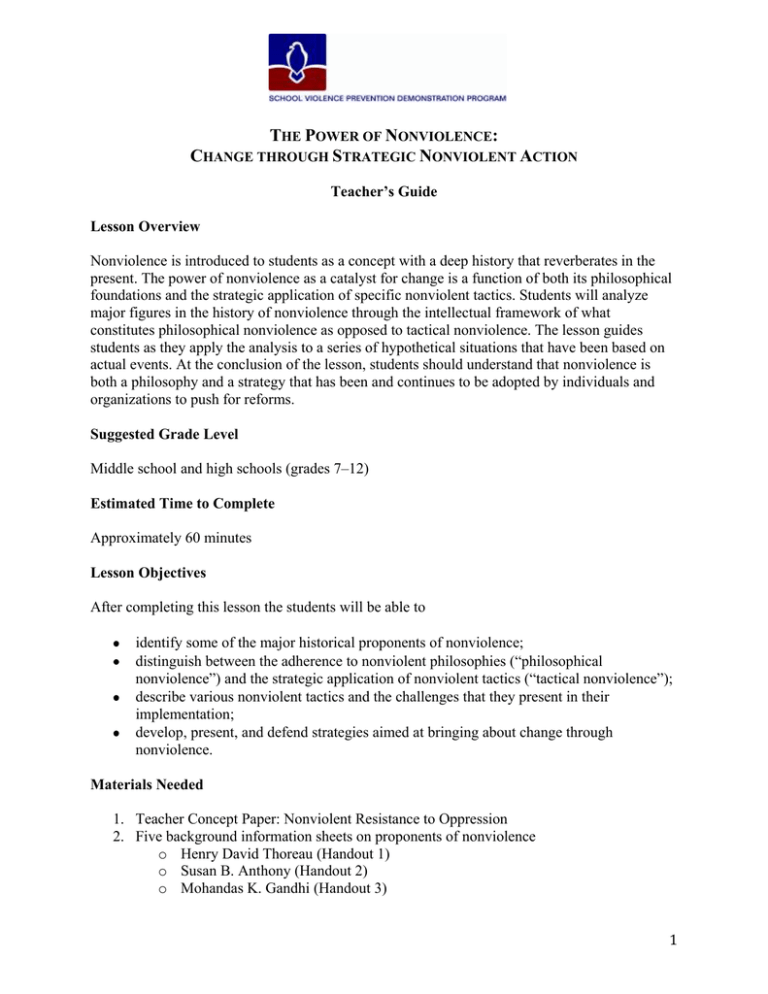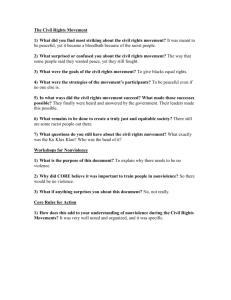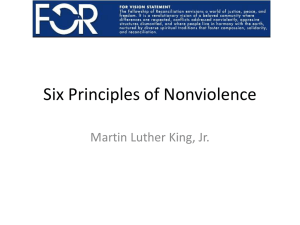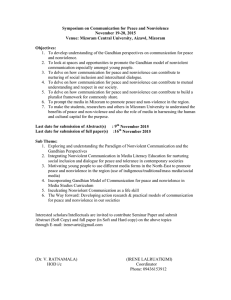
THE POWER OF NONVIOLENCE:
CHANGE THROUGH STRATEGIC NONVIOLENT ACTION
Teacher’s Guide
Lesson Overview
Nonviolence is introduced to students as a concept with a deep history that reverberates in the
present. The power of nonviolence as a catalyst for change is a function of both its philosophical
foundations and the strategic application of specific nonviolent tactics. Students will analyze
major figures in the history of nonviolence through the intellectual framework of what
constitutes philosophical nonviolence as opposed to tactical nonviolence. The lesson guides
students as they apply the analysis to a series of hypothetical situations that have been based on
actual events. At the conclusion of the lesson, students should understand that nonviolence is
both a philosophy and a strategy that has been and continues to be adopted by individuals and
organizations to push for reforms.
Suggested Grade Level
Middle school and high schools (grades 7–12)
Estimated Time to Complete
Approximately 60 minutes
Lesson Objectives
After completing this lesson the students will be able to
identify some of the major historical proponents of nonviolence;
distinguish between the adherence to nonviolent philosophies (“philosophical
nonviolence”) and the strategic application of nonviolent tactics (“tactical nonviolence”);
describe various nonviolent tactics and the challenges that they present in their
implementation;
develop, present, and defend strategies aimed at bringing about change through
nonviolence.
Materials Needed
1. Teacher Concept Paper: Nonviolent Resistance to Oppression
2. Five background information sheets on proponents of nonviolence
o Henry David Thoreau (Handout 1)
o Susan B. Anthony (Handout 2)
o Mohandas K. Gandhi (Handout 3)
1
o Martin Luther King Jr. (Handout 4)
o Cesar Chavez (Handout 5)
3. Copy for each student of Hypotheticals: Change through Strategic Nonviolent Action
(Handout 6)
4. Articles on facts underlying hypothetical situations:
o Hypothetical 1: Based on Bob Jones University:
http://www.washingtonpost.com/wp-srv/WPcap/2000-03/05/096r-030500idx.html
o Hypothetical 2: Based on Shoal Creek Country Club:
http://www.nytimes.com/1990/12/30/sports/shoal-creek-transition.html
o Hypothetical 3: Based on John Pickle Co. in Tulsa, Oklahoma:
http://www.tulsaworld.com/news/article.aspx?articleID=060525_Ne_A1_Judgm1
8802
o Hypothetical 4: Based on http://www.usatoday.com/money/workplace/2005-0216-pregnancy-bias-usat_x.htm
Lesson Procedure
1. Beginning the lesson. Ask students to share their understanding of nonviolence as a
historical concept and as it practically applies to their everyday lives. Write the terms
philosophy, tactics, and strategy on the board and have students free associate these with
the concept of nonviolence. Write down the results of the free association on the board
and leave it there for the duration of the lesson. Introduce the lesson topic and review the
purpose of the lesson with students.
2. Studying historical proponents of nonviolence. Divide the class into pairs and distribute
to each pair one background sheet on one of the following major proponents of
nonviolence: Henry David Thoreau (Handout 1), Susan B. Anthony (Handout 2),
Mohandas K. Gandhi (Handout 3), Martin Luther King Jr. (Handout 4), and Cesar
Chavez (Handout 5). Each pair of students will focus on only one proponent. You might
pause here to define proponent.
Ask each set of paired students to draw a table composed of three columns on a blank
sheet of paper, with the columns labeled: (1) Who am I? (2) What did I believe? (3) How
did I act on my beliefs? After reading the background information, the students should
write notes in each column that respond to the question being posed about their assigned
proponent.
After students have completed the columns, call on each pair to report highlights of their
notes to the class. Use these to create a master table on the board for each of the
proponents.
Please note that more than one pair of students can be assigned the same proponent.
Teacher may then call on pairs who worked on the same proponent at the same time.
2
3. Defining philosophy v. tactics. Return to the free association between philosophy, tactics,
strategy, and nonviolence. Ask the entire class to categorize the quotes and actions in the
background sheets as reflecting either philosophical or tactical nonviolence. Guide the
class as it comes up with working definitions of philosophical nonviolence and tactical
nonviolence. What is the difference between the two? Are the two indivisible? Why does
it matter whether something gets labeled as philosophical or tactical? Does a nonviolence
strategy require both? Please note that useful background information for teachers may be
found in the Teacher Concept Paper: Nonviolent Resistance to Oppression.
4.
Tackling change hypotheticals. Distribute the hypothetical situation sheet to students,
and then divide the class into four groups, assigning one of the four hypothetical
situations to each group. Explain that each hypothetical situation sheet describes a
situation that the students, as a group, will seek to reform. Ask students to work in their
groups to develop a nonviolent strategy that reflects their own nonviolence philosophy (if
any) and includes specific nonviolent tactics to bring about the desired reforms. The
strategy and a clear statement of its objectives should be prepared for presentation to the
class. Visual aids may be used to complement the presentation.
Ask each group to present its hypothetical situation and its proposed strategy of
nonviolent action aimed at reform. The other groups should offer constructive critiques of
the student group proposals following the presentation. Time permitting, presenting
groups may respond to the critiques of their proposals.
5. Concluding the lesson. To conclude the lesson, distribute articles describing the factual
situations that served as the basis for the hypotheticals. Lead students in a discussion
comparing the hypothetical situations to the actual facts and examine the types of
nonviolent tactics actually used and their effectiveness.
6. Assessment. Assign students to search for articles about a current situation that they
would like to change. Ask the students to write one-page memos addressed to their fellow
students summarizing the situation and then presenting a nonviolent campaign aimed at
reforming the situation. In their memo, students may also predict the reaction to their
proposed campaign and how best to anticipate and address that response.
This lesson was developed under a grant from the U.S. Department of Education. However, the contents do
of this lesson do not necessarily represent the policy of the Department of Education, and you should not
assume endorsement by the federal government.
© 2010, Center for Civic Education. All rights reserved. Permission is granted to freely reproduce and use
this lesson for nonprofit, classroom use only. Copyright must be acknowledged on all copies.
3



